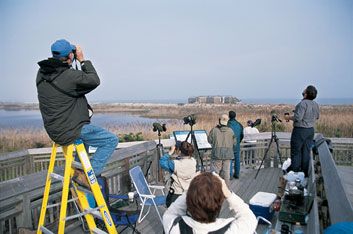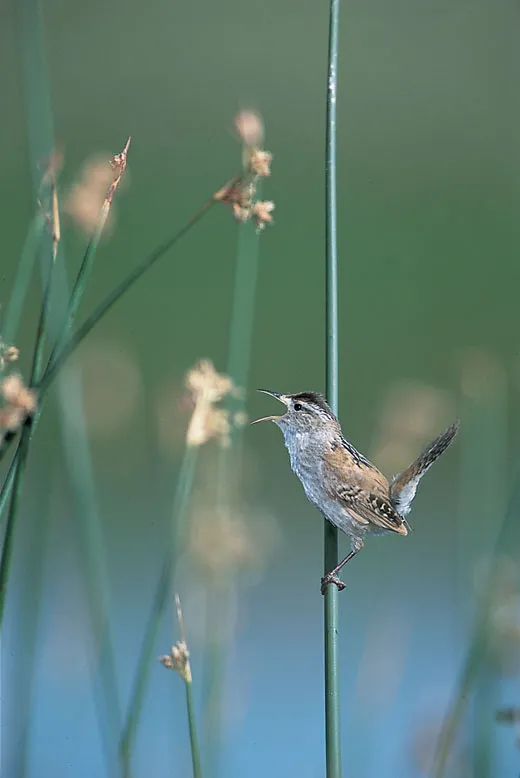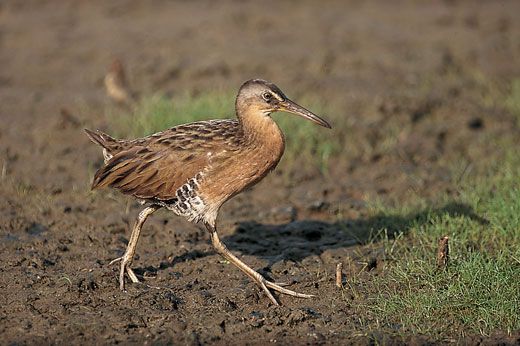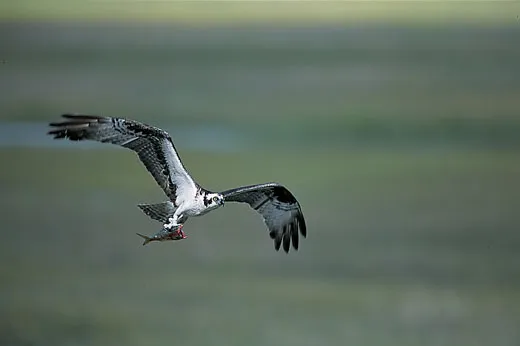Birds of a Feather
Scores of teams battle for fame and glory in the no-holds-barred World Series of Birding
Half past midnight in New Jersey's Great Swamp is an eerie time in an eerie place. Thick ground fog swirls around snags of beeches and oaks. A cuckoo calls in the distance, a grace note above the throaty chortles of frogs. Otherwise, all is still. Out of the shadows stride five men in muck boots. They slosh out into a bog, and with inexplicable simultaneity, begin applauding wildly. Just as suddenly, they stop. They seem to be listening—for what? They all strike the same cocked-ear pose, hold it for about 30 motionless seconds, do a quick about-face, clamber into a minivan and disappear down a gravel road into the murky night.
So it goes in the World Series of Birding (WSB)—a 24-hour marathon of competitive birding among teams splayed over the state of New Jersey in a nonstop, nonsleep effort to identify as many species as possible by sound or sight. Next month will mark the 21st anniversary of the event. It's all for a good cause—teams solicit pledges and raise money for bird-related conservation programs—but the WSB is as removed from your average weekend of birding as high-stakes Las Vegas poker is from a casual round of Go Fish. Indeed, the five men in the Great Swamp—who had hoped to elicit calls from a rail by clapping their hands, I later learn—hail from that bastion of bird research, the Cornell University Laboratory of Ornithology. The Cornell Sapsuckers, as they are called, won the event in 2002 with 224 species, and I was with them in 2003 as they finalized their strategies in defense of their title.
The days leading up to the competition culminate weeks of scouting to determine where the birds are. (With new birds migrating to the state every day, data must be fresh.) As kickoff time approaches, the Sapsuckers and their four or five volunteers pore over intelligence and rare-bird alerts posted on-line by local birders for all the teams in order to build camaraderie. The Sapsuckers even share key sightings with other top teams, including their nemesis, the Delaware Valley Ornithological Club Lagerhead Shrikes. (The Sapsuckers finished second to the Shrikes in 2000 and tied them in 2001.)
"I hate finishing second," grouses Sapsucker John Fitzpatrick, a longtime team member and director of the Cornell Lab. "For us, it's as serious as Michael Jordan heading for the playoffs." Six hours before midnight, Fitzpatrick huddles over maps, printouts and yellow legal pads with Kevin McGowan, a Cornell research associate, worried that the Sapsuckers' planned 24-hour, 600-mile itinerary is 40 minutes too long. "Anybody can go out and identify birds," says McGowan. "But the thing that makes a winning team is knowing where the birds are. It takes an understanding of time. You can't be distracted. You can't be pulled off your game."
He turns to Fitzpatrick and begins to speak what sounds to me like gobbledygook: "We just can't take six minutes for the godwit." "Gannets?" Fitzgerald asks, pointing to a spot on a map. "No," McGowan replies, "but there's a white-winged scoter at Sunset Beach that's a gimme." A cellphone rings. "Two red-necked grebes at the dove spot," says McGowan. "OK," says Fitzgerald, "we cut out two minutes there, go across the bridge, take a left turn and get up to the piping plover."
As the men speak their curious language, team captain Ken Rosenberg makes peanut butter sandwiches. Team members Jeff Wells and Steve Kelling listen to a CD of birdcalls—brushing up on the difference between gray-cheeked and wood thrushes.
After dinner, naps and showers, the Sapsuckers load their van with ice chests, flasks of coffee, five spotting scopes on tripods and five pairs of binoculars. Just before midnight, they roll into the Great Swamp, a national wildlife refuge about 30 miles from New York City. Precisely at the stroke of 12, they start calling for screech owls. By the time they wade into the bog to clap for rails, the mist-shrouded marshland has yielded calls from an American woodcock, black-billed and yellow-billed cuckoos, a marsh wren and an ovenbird. But no screech owl.
Identifying birds in the dark is obviously an aural process. The Sapsuckers know birdcalls as you and I know a telephone ring from a doorbell. About half the birds on a team's final list will have only been heard, not seen.
Nobody checks on these guys; it's the honor system all the way. And identifications for at least 95 percent of the birds on a team's list must be unanimous. Up to 5 percent of a team's total can be counted if only two members hear or see the birds. A few days earlier I had asked event founder Pete Dunne if birders sometimes hear or see with their hearts. He shook his head. "Very few of the birds are helped along by wishful thinking," he assured me. "There may be some birds on some lists that are wrong. But no one wants to win by goofing or by inflating their list." The greater risk is lingering too long for a particular bird and falling behind schedule. Knowing when to call it quits and move on is the key to winning.
It's now 1:20 a.m. and the Sapsuckers are headed for the Hackensack Meadowlands, where abandoned municipal waste sites and industrial complexes cozy up to reclaimed wetlands. Water birds flourish here, and birders with scopes can pick out species under the amber glow of industrial lights. Here the Sapsuckers score a black skimmer, a gadwall, even a barn owl.
Or so I'm later told, having been exiled from the Sapsuckers' van during the actual competition. Journalists were embedded with tank brigades in Iraq, but I could not ride around New Jersey with five bird-watchers. "Our concern is any form of distraction," Ken Rosenberg had explained.
Instead, I teamed up with two Cornell videographers filming the Sapsuckers' exploits. Armed with the team itinerary and a state atlas, we raced ahead to capture them in action.
At dawn, we find ourselves high on a hill just outside High Point State Park in northwestern New Jersey watching a pair of herons soar overhead, backlit by a soft sunrise. Catbirds and Nashville warblers trill in the woods. A flock of Canada geese honks by and a bald eagle strafes a nearby lake. The Sapsuckers, one of several WSB teams on hand, ignore us and begin making a soft generic birdcall that sounds like the word "pish." "Pish, pish, pish," they intone for about a minute; a quick shared glance serves as assent as they rack up yellow-throated vireo, black-throated blue warbler, purple finch. Then the Sapsuckers are gone.
At a rendezvous spot in Salem County 120 miles south, they ignore a ruddy duck cruising a pond, osprey soaring overhead and warblers warbling in the woods. They have eastern meadowlark on their minds. They get one within seconds, bag a bobolink for good measure, and again they're off. We won’t see them again till dusk at Cape May, where they will train their scopes on shorebirds.
10:00 p.m. Two hours to go and the Sapsuckers stand statue-still, ears cocked, on a jetty protruding into the tidal marshes of Cape May. John Fitzpatrick motions me over and whispers, "Flocks of migratory birds overhead." I hear only the drone of distant boats and cars. Above, I see nothing, hear nothing. Now the Sapsuckers exchange looks all around, nodding. Back to the pose. They hold it for a long time. Then another glance, another nod. These guys seem to glean birds out of the vapor, in this case gray-cheeked and Swainson's thrush.
"Deep listening," Ken Rosenberg calls it. "The essence of the World Series is extreme focus, listening beyond any normal range, the endurance to keep scanning the sky and distant horizons when our eyeballs scream to be closed—the continuous hyper level of awareness in the face of exhaustion."
Alas, the Sapsuckers' strong ending is not enough to compensate for a weak start. Shortly after midnight, the tallies are posted at the Cape May finish line: Lagerhead Shrikes 231 (a new World Series of Birding record), Sapsuckers 220.
John Fitzpatrick looks weary and dejected. "The Shrikes got out ahead of us," he says, sounding like a man for whom life has lost all savor. "If you're the second or third team to pish a spot, the birds just aren't going to come up. We missed first crack at Lincoln's sparrow, golden-crowned kinglet. We even missed white-breasted nuthatch."
Two hours later, as I am heading for my motel room and some much-needed sleep, I spot the Sapsuckers sitting beside an empty swimming pool, drinks in hand. None of us has slept for more than 40 hours. I wave and keep on walking.
"You missed it," John Fitzpatrick tells me the next morning. "A massive river of birds flew over our heads. Grosbeaks, thrushes of all kinds, cuckoos, warblers, sparrows, even an absurdly out-of-place king rail called as it flew over us! Biggest nocturnal flight I've ever heard." The Cornell Sapsuckers were no longer dethroned world champions. They were birders, doing what birders do, and they were very happy.




